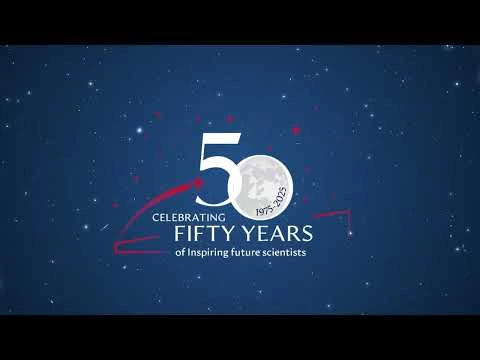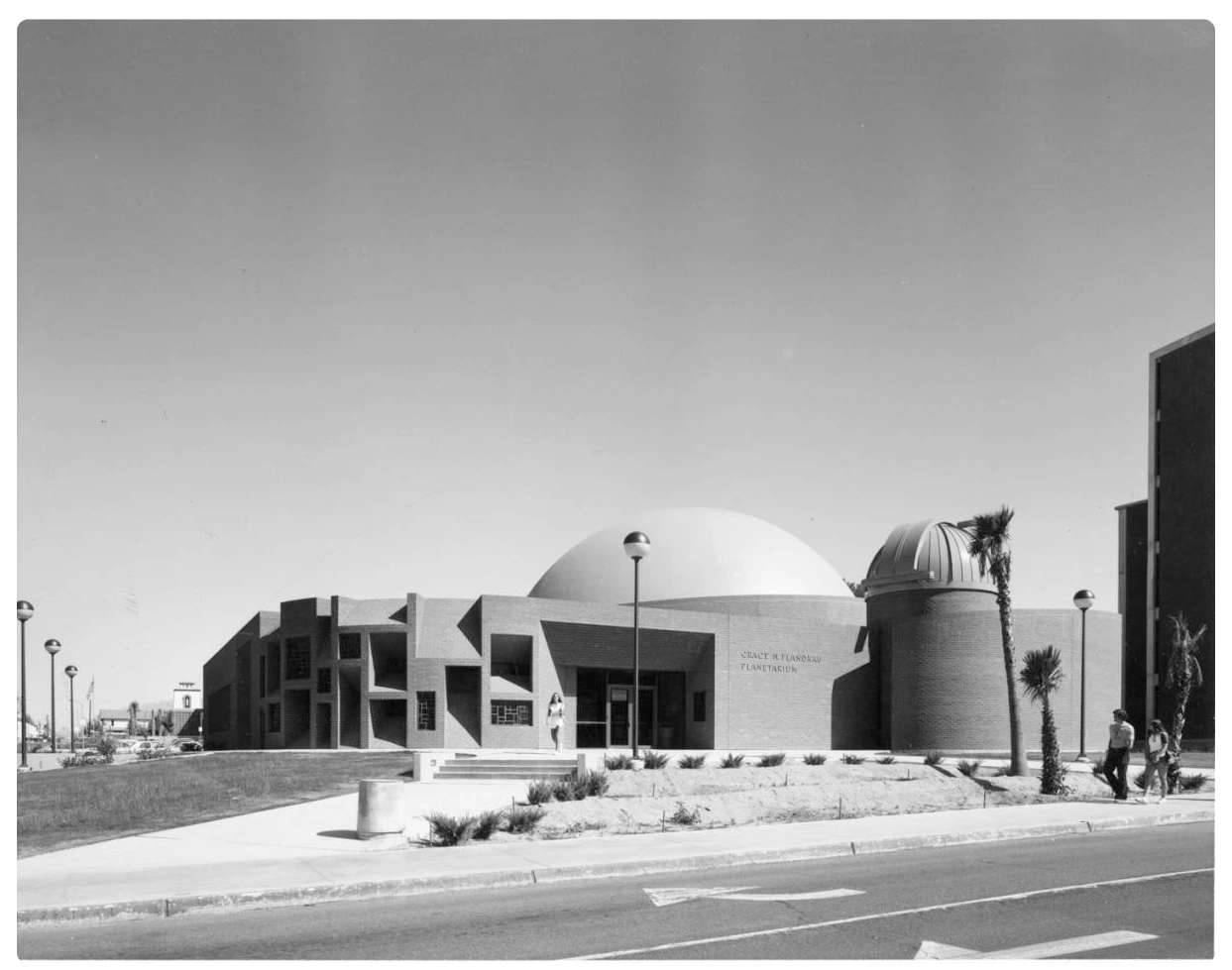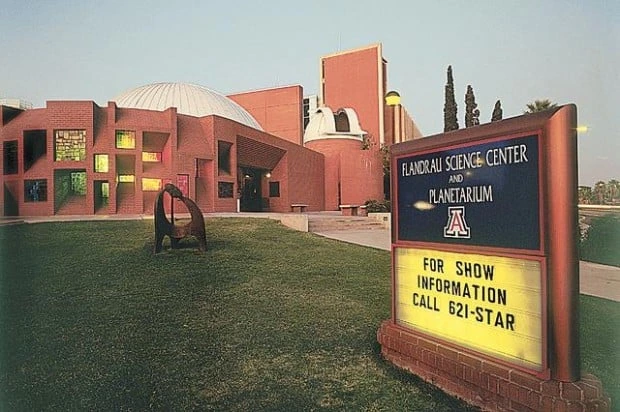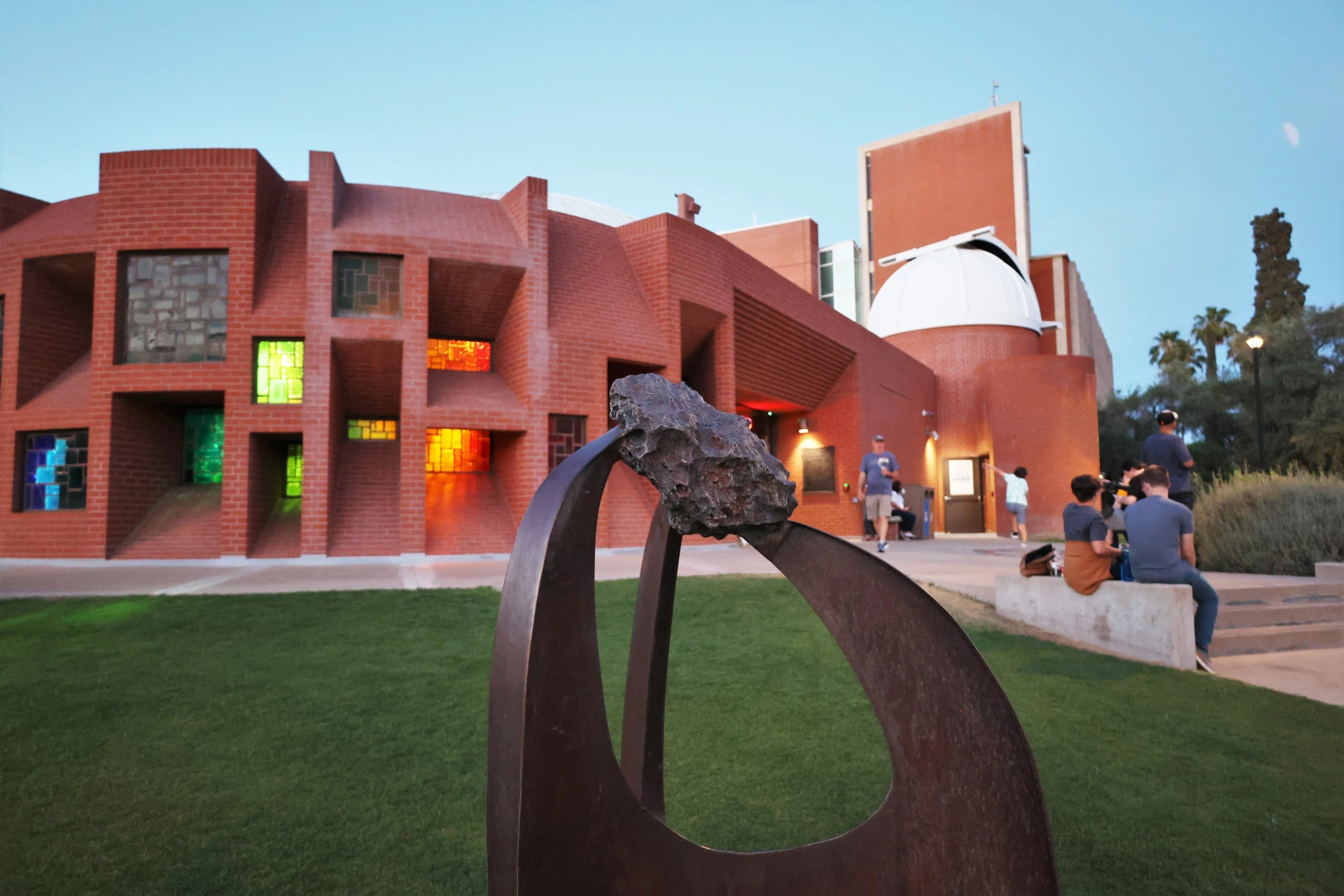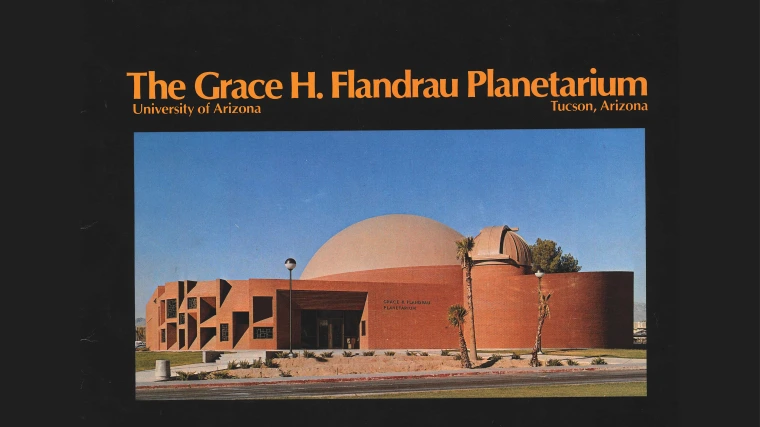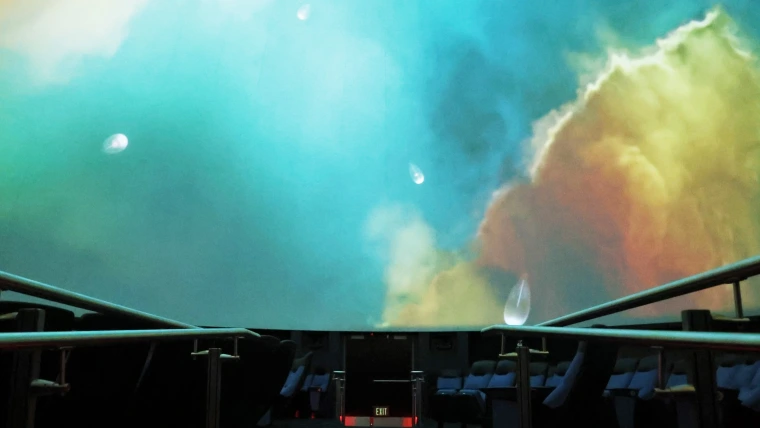
Five Decades of Discovery
Thank you Tucson and Southern Arizona for joining us on countless journeys through space, science, new technologies, astronomical community events, and educational programming over 50 years. As we lead up to our official 50th anniversary on December 13, 2025—the day we first opened our doors to the public—we invite you to celebrate with us by participating in special happenings and take a trip through time in the content below.
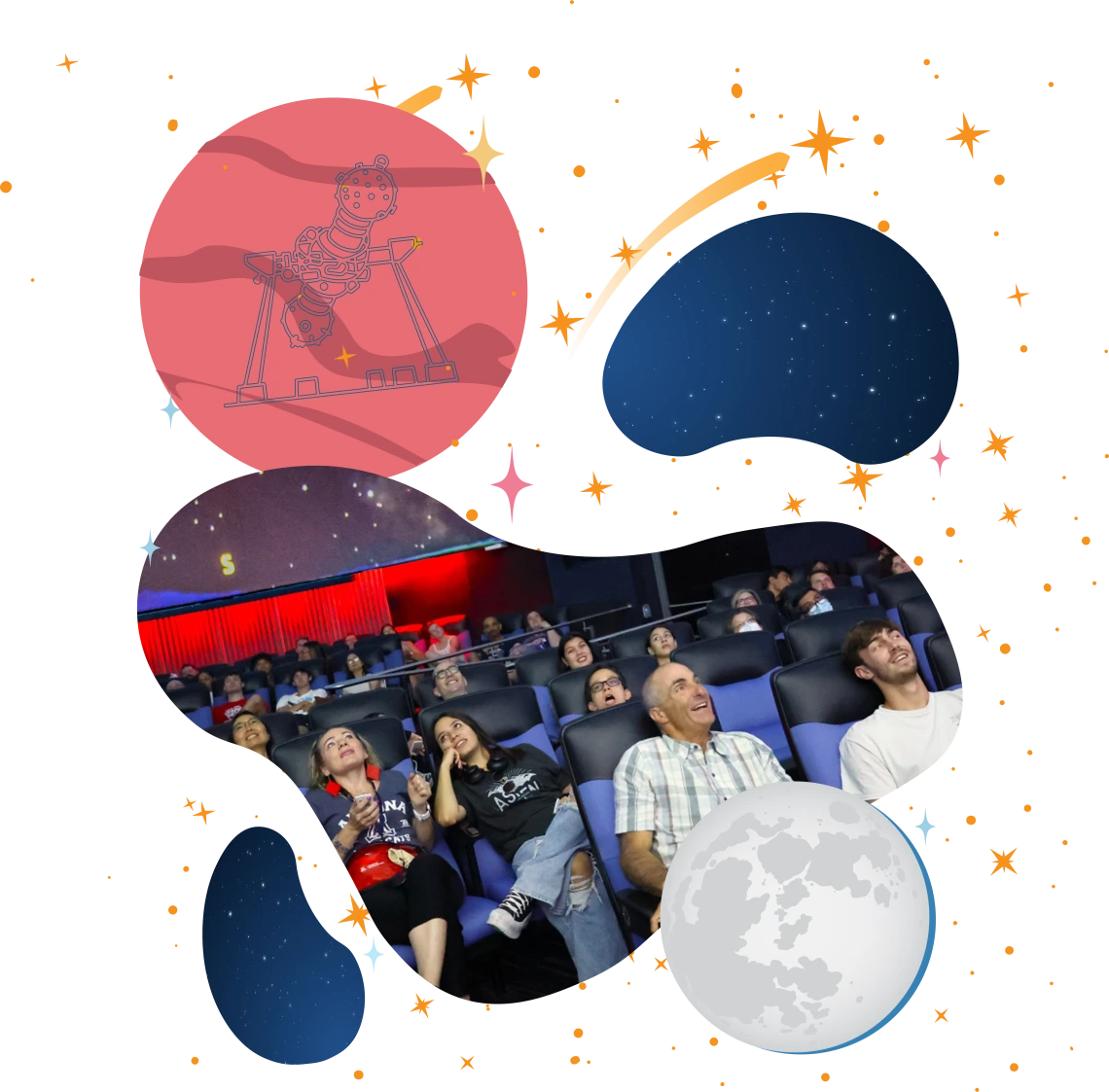
Join in on the celebration!
50th Anniversary Free Day
Last December, Flandrau celebrated 50 years of inspiring curiosity and discovery! Thank you for joining us on Saturday, December 13 for a special Free Admission Day exactly 50 years from when we first opened our doors to the public. Guests explored exhibits, planetarium shows, and hands-on learning, and celebrated five decades of science and wonder with us!
New Flandrau History Exhibit
Now open, you can peruse a small temporary exhibit that highlights the major moments, individuals, and technology that brought Southern Arizona's only science center and planetarium into existence. This exhibit will be open through early spring, before making way for the new astronomy exhibit: Mysteries of the Cosmos.

Media
Absolutely Arizona Feature
Watch KGUN9's spotlight on 50 years of Flandrau
Table of Contents
A Vision for a University Planetarium
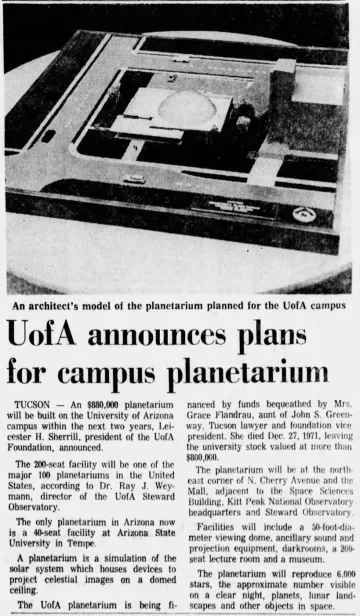
The history of the Grace H. Flandrau Planetarium began in the late 1950s and early 1960s with stellar University of Arizona scientists such as Bart Bok, Gerard Kuiper, Aden Meinel, A.M.J. “Tom” Gehrels, and Georges Van Biesbrock. As a result of their energies and expertise, the University of Arizona developed outstanding programs in astronomy, planetary science, and optics. In 1972 it became apparent that an institution sitting literally in the middle of the astronomy capital of the world should have a planetarium. The Grace H. Flandrau Planetarium was conceived as a result of the vision and leadership by then UA President John P. Schaefer, Vice President A. Richard Kassander and Head of the Department of Astronomy Ray Weymann. The planetarium got its start with a 1972 bequest from the estate of Grace H. Flandrau, noted author and frequent winter visitor to Tucson. The University decided to use the generous gift to fund a facility that would increase public understanding and appreciation of science.
As a result of the University of Arizona’s emergence as one of the premier astronomy, space science and optics centers in the United States, in 1972 the Arizona Board of Regents approved the formation of the Grace H. Flandrau Planetarium with the following statements: The Flandrau Planetarium is being designed to serve several purposes: a) To provide an instructional facility for the University of a type not now available, which should be of substantial use to departments not only in the physical sciences but also in the humanities, social sciences and performing arts: b) To provide a unique instructional facility for the school districts of Arizona in the areas of astronomy, space sciences, geology, and environmental sciences: c) To provide the community with a program of interpretation of contemporary science with special emphasis on increasing public understanding of sciences and of their interrelations of physical science with the social sciences and the humanities: d) To provide a unique research facility for various types of research on perception, orientation, sensory satiation and related topics.
Construction on the “Grace H. Flandrau Planetarium” began in 1974 and the doors opened to the public in 1975. Originally, the facility was part of the UA Department of Astronomy. Its location on campus, near the Astronomy Department, Optical Sciences Center, Lunar and Planetary Laboratory and historic Steward Observatory, reflects its continuing connections to the research community.
A Spirit of Creativity and Innovation
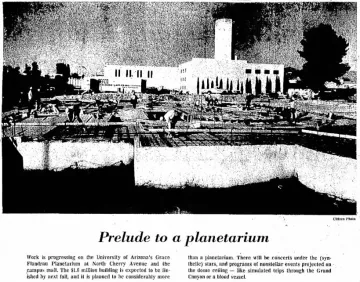
In its formative years in the late 1970s and 1980s, Flandrau produced original multimedia planetarium programs, pioneered in the development of 35mm ‘fisheye’ motion picture production/projection, and created over 30 interpretive exhibits and collections in optics, astronomy and space science. Since the cost of producing fisheye motion pictures was far more than could be borne by Flandrau, Flandrau encouraged the development of “Cinema 360”, a consortium of planetariums with similar 35mm fisheye projection systems. This early film based “fulldome” projection system technology faded in popularity during the 1990s and is now outdated. The projection equipment was removed during the 2016 “Phase 2” renovation to the planetarium theater. As part of the educational mission of Flandrau during the 1970s and 80s the Astronomy Department entered into an agreement with the Tucson Unified School District to have a full time science teacher to prepare instructional programs for K-12 school kids. The tradition is continued today as Flandrau offers discounted educational programs for school groups from all over Arizona as well as neighboring states and Mexico.
A Change in Direction

In 1989, Faculty of Science Dean, Dr. E.J. McCullough, Jr., decided that Flandrau needed new direction to increase the impact of its public understanding of science role. As a result of this direction, the facility was renamed the Flandrau Science Center and Planetarium. Operations were broken down into four major areas including the planetarium, exhibits, education and gift shop. The mission statement has evolved over the years based upon those documents that provided the mechanism for Flandrau to become established.
What is a Planetarium?

What exactly is a planetarium? Generally speaking, it is a device for showing the locations and movement of stars, planets, the sun and moon. More specifically, a planetarium is an analog computer, a simulator of sky phenomena that uses a light projection machine constructed to show positions and movements of celestial bodies on a dome projection screen under which the audience is seated.
The definition often includes the building and dome used to house the device. The traditional planetarium reproduces the night sky as it appears to people with good vision, under good conditions, accurately showing each visible object with the same position, brightness, shape, color and apparent motion as that object manifests in the true night sky. The motions of astronomical objects are imitated by projector lenses and mirrors, casting moving images on the surrounding dome. The planetarium sky can be set to show the present sky or that of the past or future. Planetarium demonstrations are usually accompanied by live or taped presentations on various astronomical topics. In a sense the dome is the presenter’s blackboard, on which objects or configurations of interest can be pointed out with a light pointer projected by a hand held device, similar to a flashlight.
The Hector Vector Years

During the early 1970s through the early 2000s Flandrau Planetarium used its traditional planetarium projector (Hector Vector the Star Projector) along with banks of slide projectors, special effect projectors, audio system and automation system to present live and/or recorded programs for public, school, university and special event audiences. These programs were produced by Flandrau staff with input from UA scientists. Many prerecorded shows were also purchased from other planetariums around the country and custom adapted to the Flandrau theater. In addition there have been a number of “special” programs presented including theater plays, musical concerts, dances and presentations by UA students completing their senior or graduate level projects.
The Emergence of New Planetarium Technologies
In 1999 a nascent technology was introduced to the planetarium community using video projectors to generate seamless images that covered the whole planetarium dome. Flandrau staff followed this developing technology and generated plans to upgrade the Flandrau planetarium theater once funding could be secured. As the technology improved and the original seating and infrastructure of the Flandrau theater began to show its age, the Flandrau staff approached the College of Science in 2010 to seek funding and make a commitment to making this new “fulldome” technology a reality as part of a fully renovated theater. It was decided to pursue renovating the theater in two phases –phase 1 would update the projection technology and sound system, and a later phase 2 would renovated the outdated seating and all major interior aspects of the theater.
Phase 1 Renovation – Flandrau Goes Fulldome
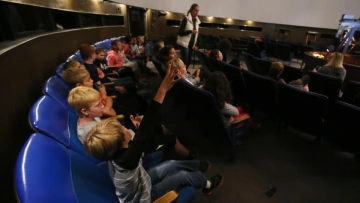
In 2013 the phase 1 funding was secured thanks to generous gifts from The Tucson Foundations, Wells Fargo, and The Eos Foundation. During the summer of 2014 a new fulldome system was installed in the planetarium theater. This state of the art technology includes 2 JVC industrial high resolution video projectors, with a computer server rack, fulldome software called “Uniview”, and a new JBL 18,000 watt Dolby 5.1 sound system. The new technology allows planetarium operators to view the night sky, show the planets, Sun and Moon and their motions, and everything else that the original projector could do, and so much more. Now visitors can travel out amongst the planets and view their features, on through the Milky Way galaxy seeing its structure, and on to other galaxies and beyond to the edge of the know universe. Plus, this new digital system is more than a “planetarium projector” in that it becomes a data visualization tool allowing data from UA scientists to be visualized and demonstrated to various audiences. It can also present pre-recorded shows from other production facilities and planetariums from around the world. These shows include state-of-the-art animations and visualizations of science topics and current science endeavors.
Phase 2 Renovation – The Eos Foundation Planetarium Theater is Born
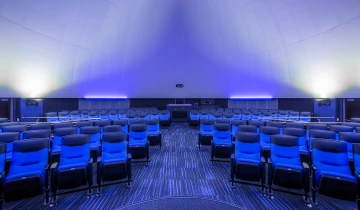
In 2015 thanks to a generous gift from The Eos Foundation, planning began for what would become the largest renovation to Flandrau since opening in 1975. The design phase for a completely updated theater began in earnest in early 2016 with plans to remove the older Hector Vector projector and upgrade the planetarium theater with new flooring, new seating, new acoustic wall treatments, new lighting, a new assistive hearing system, and more. With an aggressive schedule dictated by the University academic calendar, demolition began in June 2016 with construction completed in late August – just time for the first day of classes for the Fall Semester. The “Eos Foundation Planetarium Theater” opened officially on August 27, 2017 to rave reviews and sold out crowds.
Flandrau Today
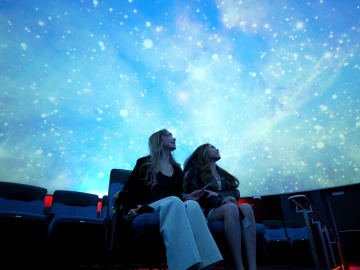
Flandrau today is a dynamic center for science learning, community connection, and immersive exploration. Recently named the number four planetarium in the country by USA Today readers, Flandrau continues to shine as one of the region’s most beloved destinations for discovering the wonders of space and science.
Inside the Eos Foundation Planetarium Theater, visitors experience stunning fulldome shows powered by advanced projection technology and powerful surround sound. These same tools also support innovative teaching for University of Arizona students, who use the dome as a classroom to explore astronomy in a way few universities can offer.
On the exhibit floor, the new Universe of Science exhibit gives guests a hands-on way to connect with everything from astronomy to monsoons to the cutting-edge research happening across campus. Interactive displays, digital features, and large-scale models invite visitors to see themselves in the world of science.
Flandrau remains deeply committed to access and equity. Through free field trip programming for Title I schools, thousands of young learners experience the excitement of astronomy and STEM each year, many stepping into a planetarium for the first time.
Each year, Flandrau welcomes tens of thousands of visitors and serves as a gathering place for major astronomical events like eclipses, as well as for science lectures, laser light shows, and community programs that bring people together under the stars.
As Flandrau continues to grow with new exhibits and experiences, it remains a gateway to discovery and a place where curiosity, community, and the Wildcat spirit of exploration continue to thrive.
Research, Writing and Editing by –
Michael Magee
Ret. Planetarium Director
Flandrau Science Center & Planetarium
"Flandrau Today" section by Nick Letson
Disclaimer: Much of the information in this article comes from existing articles written by other authors.
Historic Articles about Flandrau
| November 20, 1972 | UofA announces plans for campus planetarium | Article Link |
| February 1, 1974 | University Planetarium Projection | Article Link |
| May 13, 1974 | A date with the Stars | Article Link |
| July 3, 1974 | Flare adds flair to groundbreaking | Article Link |
| July 4, 1974 | Flandrau Planetarium Under Way | Article Link |
| December 19, 1974 | Prelude to a planetarium | Article Link |
| January 26, 1975 | Housing for Planetarium | Article Link |
| March 5, 1975 | Heavenly Arch Takes Shape | Article Link |
| April 10, 1975 | Planetarium Work Progressing | Article Link |
| July 22, 1975 | Launching Close-Up Promised | Article Link |
| September 25, 1975 | Gift for Stargazers | Article Link |
| September 25, 1975 | The Better To See Stars With | Article Link |
1975-2025
